The Experience of a Lifetime: NOAA Marine Scientists Help Protect Red Sea Coral as Part of the Middle East Peace Process
From mapping and monitoring to managing reef resources and removing harmful debris, NOAA supports effective management and sound science to preserve, sustain, and restore valuable coral reef ecosystems. Recognizing the importance of international collaboration in ocean and coastal issues such as coral reef management, NOAA often works to build and sustain capacities for global coastal and marine stewardship through effective international partnerships.
- Introduction
- A Unique Opportunity
- Setting Goals
- Management Challenges
- More NOAA Contributions
- Conclusion
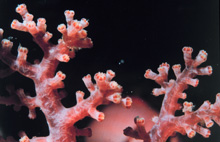
The Gulf of Aqaba, in the Red Sea, is home to many beautiful organisms, such as this carnation coral. Image courtesy of Mr. Mohammed Al Momany, Aqaba, Jordan.
Beginning in September 1994, NOAA suddenly found itself in the midst of the Middle East Peace Process when Israel and Jordan signed a treaty that called for ways to establish peace between the two nations. One measure for extending the olive branch was creating a bi-national marine park adjacent to the countries’ common border in the Red Sea. Three individuals from NOAA—Stephen Jameson, Michael Crosby, and Ben Mieremet—soon became closely involved in working with both countries to establish the park and manage its coral reefs.
While NOAA works collaboratively with other nations in many areas of science, this was an unusually high-profile international challenge and a special assignment for those involved. These individuals would be helping NOAA achieve one of its primary goals (“to protect, restore, and manage the use of coastal and ocean resources through an ecosystem approach to management”) within a much broader geo-political and diplomatic set of circumstances in an often-volatile region of the world.
The story below is told by Ben Mieremet, recounting in his own words his experience in helping to protect the corals of the Red Sea.
A Unique Opportunity
Few opportunities come along in a government employee’s life when he or she can say, “I was at the right place at the right time – lucky me!” But, I was lucky enough to say those words at the end of September 1994, while in Hawaii putting some finishing details on a draft environmental impact statement for the proposed designation of the Hawaiian Islands Humpback Whale National Marine Sanctuary.
I got a call from my boss to fly back from Hawaii immediately, get tickets and travel funds, and fly to Amman, Jordan, in three days. I was told that I would be assisting the U.S. Agency for International Development (USAID) and the Hashemite Kingdom of Jordan to develop a concept paper for the Bi-national Red Sea Marine Peace Park for the Gulf of Aqaba, an arm of the Red Sea. The paper would be presented to the government of Israel.

Israel and Jordan share a common border at the narrow, northern tip of the Gulf of Aqaba where both countries independently established marine parks to protect coral reefs. Scientists from both nations agreed that jointly managing the reefs would enhance their protection. Click image for larger view.
The impetus for the park grew out of a peace treaty between the two countries signed in 1994 as a result of the broader Middle East Peace Process. Jordan and Israel share a common border that extends into the narrow, northern tip of the Red Sea’s Gulf of Aqaba, where coral reefs attract tourists from both countries. But the reefs were suffering impacts from ship traffic, nutrient runoff, and abuse from recreational divers. Both countries realized the importance of protecting the coral reefs and had previously taken steps on their own to protect coral under their jurisdiction. However, both nations realized that in spite of their individual efforts, joint management would be necessary to best protect the reefs.
Setting Goals for the Bi-national Marine Peace Park

A Miniatus grouper from coral reefs in the Gulf of Aquaba. Click image for larger view and image credit.
The ink had not yet dried on a new resources support service agreement between my office (the Office of Ocean and Coastal Resources Management, within NOAA's National Ocean Service), and USAID for technical expertise in integrated coastal zone management. This type of management is a decision-making process that takes into account all environmental, economic, social, cultural, and recreational objectives. The process also incorporates the impacts of one set of objectives on another within existing legal and jurisdictional frameworks and within the constraints necessary to maintain a healthy and vibrant ecosystem. To receive this expertise, USAID reimburses federal agencies like NOAA to help accomplish objectives such as preventing soil erosion and providing marine fisheries expertise. The effort to establish the park was the first time that USAID had worked with a project to protect coral reefs through integrated coastal zone management.
Drafting the Concept Paper
I was to report to the American embassy in Amman and receive further instruction. Little did I realize that within the next few days, I would have the opportunity to meet with the U.S. Ambassador to Jordan and other top officials, including Jordanian ministers of tourism and antiquities, agriculture, and transportation and the Governor of the Province of Aqaba. Travelling from place to place, I had the privilege of asking these officials their visions for the new park.
From these discussions, I put together a concept paper that would show how the coral reefs of Aqaba, Jordan, and of Eilat, Israel, could be managed in such a way as to increase the tourism potential of what was to be a new economic free-trade zone where border barriers would diminish and trade and tourism would increase.
The Peace Process
The Peace Process between Jordan and Israel was significant, involving multi-lateral, tri-lateral, and bi-lateral negotiations. Until 1994, Israel had established diplomatic relations among its Arab neighbors only with Egypt. However, because of the vision of Israel’s Prime Minister Itzak Rabin and Jordan’s King Hussein, the two former enemies agreed to a peace treaty following many years of belligerency.
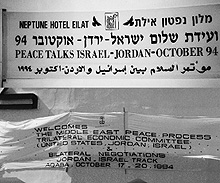
As part the Middle East peace talks, U.S., Jordanian, and Israeli delegations met in Eilat, Israel, and Aqaba, Jordan, in October 1994 to discuss tourism, the environment, water, and border security prior to signing of the peace treaty by both Mideast nations later that month. Click image for larger view.
As part of the tri-lateral negotiation process (Israel, Jordan, and the United States), a Jordanian delegation was to meet in Eilat for a week and the Israeli delegation was to meet in Aqaba for a week to discuss tourism, the environment, water, and border security.
The Park Goals
To be part of the delegation during the first introductions was an experience I will always remember. When I mentioned I worked for NOAA, the head of the Israeli delegation was reminded of a favorite joke about Noah of biblical fame and the historic Johnstown, Pennsylvania, floods of 1889 and 1977. Everyone got a good laugh and negotiations went smoothly. Israel liked the concept paper submitted by the Jordanian delegation and the Bi-national Red Sea Marine Peace Park found acceptance.
The goals of the park would be to:
- Contribute to preserving coastal ecosystems and their biodiversity;
- Promote sustainable economic development and ensure that tourism/recreational uses of the park were environmentally sound;
- Prevent deterioration of existing ecosystems;
- Rehabilitate, restore, and enhance damaged natural coastal and marine resources in the park;
- Promote environmental awareness programs to achieve the objectives above;
- Identify research needs of problems related to park operation and maintenance.
Management Challenges for the Park
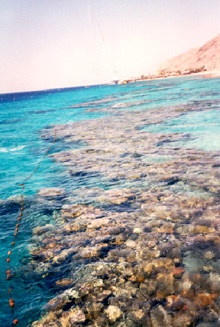
A heavily dried coral reef in Eilat, Israel, managed by the Nature Reserves Authority.
Scientists and coral reef resource managers in both nations faced many challenges. The one-kilometer long coral reef at Eilat had suffered severe impacts from oil spills and heavy diver use over a 20-year period and was only just beginning to be managed to control abuse such as touching and taking coral souvenirs. Unmanaged fishing nets were also heavily damaging the coral reserves of Aqaba. Prior to the peace accord, scientists could not develop adequate models of oceanographic currents in the Gulf of Aqaba to better understand coral recruitment, oil spill trajectories, and chemical and biological changes affecting coral growth. By signing a peace treaty, Israel and Jordan created the opportunity for collaboration.
More NOAA Contributions
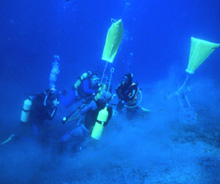
Both nations had only begun to address heavy diver use of coral reefs prior to the 1994 peace treaty that called for bi-national management of Jordan’s and Israel’s Red Sea coral reefs.
Naturally, it takes money to encourage collaboration, so one of my jobs was to apply for funding to assist the parties in establishing the park. Writing proposals for competitive grants, I was able to obtain nearly $3 million. Using the NOAA employee “loan” process, I enlisted the services of Lieutenant Commander Stephen Jameson, a NOAA Corps Officer with considerable marine park management experience and a Ph.D. candidate in coral reef ecology, and Dr. Michael Crosby, a coral reef expert who worked at NOAA headquarters. Both men would help to facilitate cooperative research efforts afforded by a $2.6 million grant from the USAID Middle East Regional Cooperation Program.
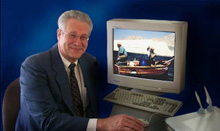
Ben Mierement, author of this article, displaying one of his photographs from his work to establish the Bi-national Red Sea Marine Peace Park. The image on the screen behind Ben shows tuna fishermen at work off the shore of Aqaba.
Steve did a phenomenal job in technology transfer, especially to Jordan, whose coral reef park was in a nascent stage of development. He arranged a trip for a large contingent of park managers and scientists from Jordan and Israel to visit the Florida Keys National Marine Sanctuary and Glacier National Park, a bi-national peace park between Canada and the United States. He ordered buoys and installation equipment for Jordan to be used to demarcate the park boundary and to provide floats where boats could tie-up rather than drop anchor and damage the reef. He arranged for two Florida Keys experts to train the Jordanians in Aqaba how to use the equipment and install the buoys.
Dr. Crosby’s contributions to keep the peace process going between scientists and park managers over a four-year period following the treaty signing was nothing less than exceptional.
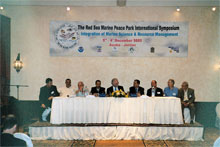
Dr. Michael Crosby (center) moderates a panel of Jordanian and Israeli scientists who summarized their years of collaborative oceanographic research. Click image for larger view.
I had the privilege of making 16 trips to Jordan and Israel and several to Egypt as we collaborated with the park managers of the Ras Mohammed National Park, a protected area with coral reefs at the southern end of the Gulf of Aqaba. Jordan, through the Aqaba Regional Authority, was always the perfect host and sponsored several significant workshops. One of the workshops was the International Coral Reef Initiative Middle East Regional Workshop, which supported representatives of Yeman, Oman, Egypt, Djibouti, Eritrea, Israel, environmental non-governmental organizations (NGO), and others to discuss the coral reef opportunities and challenges in each nation’s coastal waters.
With a modest transfer of funds to EcoPeace, an environmental NGO with representatives from several of the Middle East nations, Egypt, Israel, and Jordan held the first coordinated beach cleanup in September 1995, with hundreds of school children participating. In each case, NOAA was a proud participant in a significant process to make our world just a little better place to live.
The growth from tourism and development that was contemplated in 1994 has, in large measure, taken place without abatement. The growth is occurring with some forethough because of the collaboration between scientists and park managers, bt all concerned keep their fingers crossed for the "fragile ring of life" just a few feet from their shorelines.
Conclusion

Ben Mieremet (right) and Steve Jameson (center) meet with Princess Basma Ali (Royal Executive Director of the Jordanian Royal Environmental Diving Society) at NOAA headquarters in Silver Spring, Maryland. Princess Basma worked tirelessly to facilitate marine conservation efforts within the Bi-national Marine Peace Park.
Although NOAA is a science organization, its work sometimes transcends pure science to fit within a broader geo-political landscape. And so it was with the Red Sea Bi-national Marine Peace Park that NOAA helped to establish in 1994. Its collaborative work with Jordan and Israel to create the park was equal parts science, diplomacy, and goodwill.
The opportunity to work internationally with high-level officials and scientists from Israel and Jordan; to protect, restore, and manage coral reefs in the Red Sea; and to contribute toward the Middle East Peace Process makes me realize that I am one of a few lucky ones, along with Steve and Mike, who were fortunate enough to be in the right place at the right time to help carry out this important NOAA mission as well as a mission important to world peace.
It is not hard to see that the great peoples of the Middle East would rather live in peace, visit each other's countries, and work together to solve problems—many of which need sound science to resolve—than to be in a belligerent state with one another. May we all say with equal passion: Shalom and Salem – may peace be with you.
Contributed by Ben Mieremet, NOAA’s National Ocean Service, Senior Policy Analyst (Retired)
